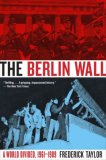Summary | Excerpt | Reviews | Beyond the Book | Readalikes | Genres & Themes | Author Bio

Critics' Opinion:
Readers' Opinion:
First Published:
May 2007, 512 pages
Paperback:
May 2008, 528 pages
 Book Reviewed by:
Book Reviewed by:
BookBrowse Review Team
Buy This Book
Chapter One
Marsh Town
In the summer of 1961, sixteen years after the end of the Second World War, the world was faced for the first time with the realistic threat of nuclear annihilation.
The background cause was the development, during the 1950s, of massively destructive nuclear weapons by both East and West. The immediate reason was the construction of a wall, a wall dividing a city built on sand.
Berlin, where this ominous thing happened, had always been an improbable metropolis. A fishing and trading settlement, surviving on sandy, boggy soil, it then became capital of one of the poorest monarchies in Europe: Prussia, a state whose very weakness gradually became its strength, and whose habitual trade of military violence—forced on it by its meagreness of natural resources—made it powerful, and Berlin one of the great urban centres of the world.
So how and when did the city's rise begin?
Twentieth-century Berlin was divided. And at its very beginning it also consisted of two cities—or rather, large villages. One was called Berlin and the other Colln, located on opposite sandy banks at a narrow point in the northward flow of the river Spree. Colln on the western bank owed its name to the ancient western German Christian city founded by the Romans, Cologne (Köln in German); on the eastern side, the settlement of Berlin was probably not named after the noble bear as sentimental natives still insist—but more prosaically after the old West Slavic word for marsh, brl. Marsh town.
Two heritages found expression in those two names. One was brought with them by the Germanic colonists from the West who flocked into the Slav lands between the Elbe and the Oder as these were conquered. The other expressed the lasting spirit of the non-German people who lived here until this time. These people were gradually Germanised but remained, in some mysterious way that would frustrate later theorists of racial purity, not pure 'Aryan' in the Nazi sense. This was the Berlin 'mix', reinforced by mass immigrations from the eastern and southern regions of Europe in the nineteenth and early twentieth centuries, when the capital of the united Germany became one of the great boom towns of the continent.
At the beginning the expansion of the twin settlement was gradual. There was no fertile hinterland, but Berlin-Cölln's location was sufficiently convenient that it grew steadily on the basis of the Baltic river-borne trade with landlocked central Europe. Local rye and oak timber were shipped north along the veins of the waterways that covered the North German Plain, and in exchange herring and dried cod came from Hamburg. Later, Thuringia supplied iron, Flanders fine cloth, and even oils and Mediterranean exotica such as figs and ginger found their way there. Walls were built. Soon a mill-dam straddled the Spree. In 1307, the towns merged.
Berlin-Cölln owed allegiance to a local magnate. Its overlord was the Margrave of Brandenburg, to whom annual taxes were paid. Though represented by a governor, the margrave left the town mostly to its own devices.
City magistrates and guilds, dominated by patrician families, regulated everyday economic and social life. Punishments were harsh. Crimes that warranted death or lethal torture included not just murder or treason but also poisoning, practising black magic or witchcraft, arson and adultery. Between 1391 and 1448, in a town with a consistent population of around 8,000 souls, 46 alleged miscreants were hanged, 20 burned at the stake, 22 beheaded, 11 broken on the wheel, 17 buried alive (a specially favoured fate for women), and 13 tortured to death.' Countless mutilations, including severing of hands, slicing of ears, and ripping out of tongues, were administered for lesser transgressions.
Nevertheless, town life even under such harsh conditions offered a certain security, and relative freedom. Stadt Luft macht frei, as the ancient German saying went—'City air makes a man free'.
The foregoing is excerpted from The Berlin Wall by Frederick Taylor. All rights reserved. No part of this book may be used or reproduced without written permission from HarperCollins Publishers, 10 East 53rd Street, New York, NY 10022





The Funeral Cryer by Wenyan Lu
Debut novelist Wenyan Lu brings us this witty yet profound story about one woman's midlife reawakening in contemporary rural China.
Your guide toexceptional books
BookBrowse seeks out and recommends the best in contemporary fiction and nonfiction—books that not only engage and entertain but also deepen our understanding of ourselves and the world around us.